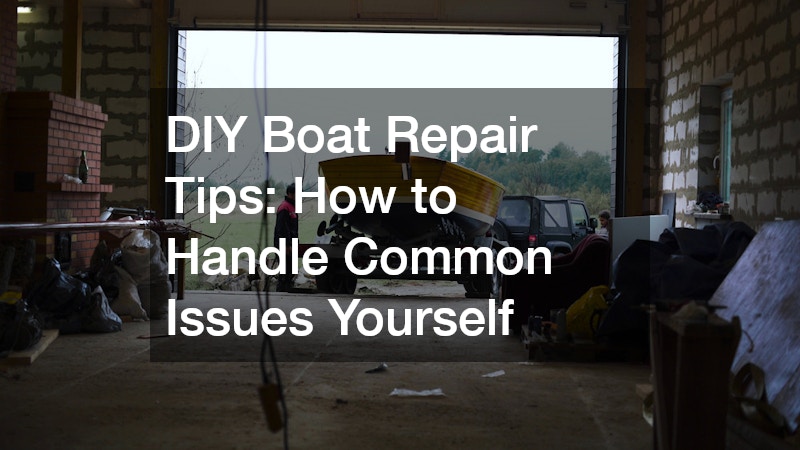DIY Boat Repair Tips How to Handle Common Issues Yourself

Embarking on DIY boat repair projects can be significantly beneficial for boat owners. Not only does it save money by avoiding professional fees, but it also boosts self-reliance, ensuring you’re prepared to manage your boat’s condition. Furthermore, understanding your vessel’s ins and outs can enhance safety and performance.
Performing repairs yourself decreases dependency on professionals, adding a personalized touch to your maintenance routine. It grants you control over every detail, ensuring that no area goes unnoticed or unchecked. Additionally, it’s much easier to identify minor issues before they escalate into major problems, saving time and effort in the long run.
Enhancing your mechanical and technical skills through DIY repair builds confidence and proficiency. With the right approach and tools, addressing boat issues can become a rewarding hobby. Moreover, familiarity with your vessel’s condition fosters a sense of connection and understanding through hands-on experience.
Identifying Hull Damage
Identifying hull damage promptly is crucial for every boat owner. Signs such as cracks, blisters, or discoloration on the hull’s surface can indicate a deeper issue. Assessing the damage severity helps determine whether a simple repair or professional intervention is necessary, preventing further damage.
Pay close attention to any water seepage into the boat, which often signals an underlying problem. Regular inspections can help catch these signs early, minimizing risks on the water. If the damage appears extensive or compromises the hull’s integrity, seeking professional advice may be warranted.
Understanding the common causes of hull damage, such as impacts, abrasion, or poor maintenance, can guide preventive measures. Early detection and repair are key in maintaining the boat’s performance and longevity. Ensuring your boat stays in top condition guarantees safer and more enjoyable voyages.
Materials Needed for DIY Hull Repair
Before commencing hull repairs, gathering the necessary materials ensures efficiency and success. Fiberglass repair kits are essential, providing the components needed for patching up minor damages. Epoxy resin aids in sealing and strengthening the affected area, ensuring a durable finish.
Sandpaper is crucial for surface preparation, ensuring the area is smooth and ready for repair. Properly preparing your materials beforehand can prevent unnecessary interruptions during the repair process. Don’t forget personal protective equipment, such as gloves and goggles, to ensure safety during the repair.
Step-by-Step Repair Process
The first step in hull repair is thoroughly cleaning and drying the damaged area. Once prepped, sanding the area smooth provides an optimal surface for effective adhesion. Applying the fiberglass repair kit according to instructions ensures the patch securely bonds with the hull.
Using epoxy resin over the patched area seals and solidifies the repair, ensuring water-tightness. Allowing ample cure time prevents premature failure of the repair, ensuring long-lasting resilience. Finally, sanding the repaired area again provides a smooth and polished finish, restoring the hull’s appearance.
Basic Engine Maintenance Tips
Routine engine maintenance is vital for preserving your boat’s operational efficiency. Regular oil changes, typically every 50 hours of operation, prevent engine wear and contamination. Replacing filters, including oil, fuel, and air filters, ensures clean flow and optimal performance.
Checking and maintaining coolant levels prevents overheating and potential engine damage. Inspecting belts and hoses for wear or cracks helps avoid sudden breakages during outings. Keeping battery terminals clean and securely connected prevents electrical issues affecting engine starting and performance.
DIY Engine Repair Techniques
Tackling straightforward engine repairs on your own requires understanding the basics first. Begin by consulting your engine’s manual for specific troubleshooting steps. Addressing minor issues like worn-out spark plugs or fuel line blockages often demands simple tools and patience.
If the engine struggles to start, check for proper fuel flow and a healthy battery charge. Regular inspection of electrical connections can prevent unexpected failures during engine operation. For persistent issues beyond DIY capabilities, consulting a marine technician may be necessary.
Performing Simple Electrical Repairs
Conducting basic electrical repairs can be straightforward with the right knowledge and tools. Replacing fuses requires checking the correct amperage and ensuring replacements fit securely. Repairing connections, such as tightening screws or cleaning battery terminals, restores reliable power flow.
Maintaining battery health involves regular charging and monitoring electrolyte levels for lead-acid batteries. Applying dielectric grease on terminals can prevent corrosion and ensure long-term reliability. Simple repairs contribute significantly to the consistent performance of your boat’s electrical system.
Equipping yourself with a basic toolkit and spare parts helps address minor issues quickly. Being proactive in repairs maximizes the functionality and lifespan of electrical components. Ultimately, mastering these skills advances your ability to perform thorough maintenance independently.
Mastering DIY boat repair not only embodies resourcefulness but also enhances your boating experience. Addressing hull, engine, and electrical issues independently instills confidence and familiarity with your vessel. Maintaining your boat ensures safety, reliability, and continual enjoyment on the water.
Consistent care and timely repair protect your investment and reduce operating costs significantly. Developing mechanical skills through hands-on experience provides a deeper understanding of boat systems. Looking after your boat with precision reflects dedication to quality upkeep and smooth sailing.
Incorporating these DIY repair tips into your routine transforms challenges into opportunities for growth. Therein lies the value of DIY boat repair— fostering skillset expansion and reinforcing autonomy. As you navigate through repairs, your growing expertise and confidence ensure a rewarding journey.
.







